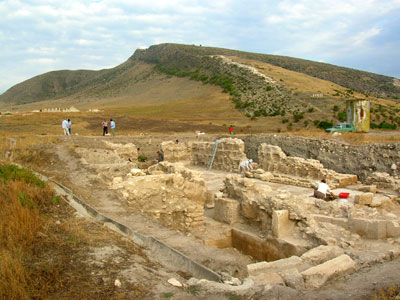Armenians target ancient Azerbaijani historical monument

By Sara Rajabova
Armenians continue their attempts to steal and falsify the rich history and culture of Azerbaijan in the lands, which they once filched from their neighbor.
The Armenian historians try to appropriate the ancient Gavur-Gala church in the occupied part of Aghdam region of Azerbaijan. Recently, they have conducted archaeological excavations in the territory of the region, trying to open the main entrance to the Gavur fortress.
The Armenian archeologists called the ancient Gavur-Gala monument as "Tigranakert Castle", although the monuments found in 1971 in an area called Gavur-Gala in Azerbaijan's Agdam has nothing to do with the Armenian culture or history.
The Gavur-Gala ancient settlement was discovered and explored by eminent Azerbaijani historian Rashid Goyushov at the end of the 20th century.
The patterns belong to the first mid centuries A.D. The Christianity was the reigning religion in Azerbaijan in ancient times, while the belief to great Goddess was also preserved as an indicator of traditional ancient Turkic faith. This three-meter stone monument exactly carries these features.
The statues, which depict a group of human figures, are one of the most original plastic art patterns discovered in Azerbaijani territory.
The figure hanging up of his hands folded on the breast, and eyes looking up to the heaven has been described in an original style. Along with elements differing the statues held in terms of style figures founded from Tovuz and Shamakhi regions of Azerbaijan, they have a lot of similarities, including resemblance in their static stance, position of hands, the size, in ethnic type, and being a long-haired.
This common style proves that these art patterns belong to Azerbaijani Turks and has no relation to Armenians.
Over the last two decades of occupation of Azerbaijani lands, Armenians could rewrite the history and manipulated the facts about the monuments, especially those belonging to ancient Albans.
The Armenians claim that ancient Caucasian Albania in the historical territories of Azerbaijan belongs to them.
Azerbaijan and Armenia fought a lengthy war that ended with the signing of a precarious cease-fire in 1994. Since then, Armenian armed forces have occupied over 20 percent of Azerbaijan's internationally recognized territory, including Nagorno-Karabakh, defying international calls and UN resolutions.
After invading Azerbaijan's territories, Armenia has been pursuing the campaign of ruining cultural and historical monuments of Azerbaijani people. The Armenians are fabricating facts about the monuments of the ancient Caucasus Albania. A variety of ancient Albanian scripts, wall designs and crosses have been replaced by Armenian attributes. A number of mosques are used as store-houses. Buildings as well as unique exhibits of the museums located in the occupied Azerbaijani lands have been either destroyed or used as a basis for new museums, with Armenians claiming that they belong to them.
The first human dwellings like the well-known Azykh and Taghlar caves, the Garakopak and Uzarliktapa burial mounds, located in the occupied territories, are being used for military purposes. Most of them have been destroyed. Cemeteries, mausoleums, monuments, mosques, temples and monuments that once belonged to Caucasus Albania and other cultural heritage sites in the occupied regions of Shusha, Lachin, Kalbajar, Gubadli, Zangilan, and Fuzuli have been destroyed along with burial mounds in Khojaly, Aghdam, Aghdara, Fuzuli and Jabrayil.
The destruction of Azerbaijani cultural monuments in the occupied territories continues to this day. The invaders are carrying out large-scale archeological excavations, destroying burial mounds.
Total damage inflicted to Azerbaijan amounts to $6.7 billion, according to approximate calculations based on the documents of 1994. The figure excludes items of intangible heritage, and it is impossible to determine the immense moral value of these destroyed, ancient and irreplaceable cultural monuments of the Azerbaijan people.
Preservation of historical and cultural monuments in the Armenia-occupied territory of Azerbaijan as memories of the nation's centuries-old history is a matter of international importance, because Azerbaijani people's cultural heritage is an integral part of the world culture.
The destruction and damaging of the historical and cultural monuments by the Armenian invaders in the occupied territories of Azerbaijan contradict the 1954 Hague convention on preservation of cultural values during armed conflicts, the 1992 European convention on preservation of archeological heritage, and the 1972 UNESCO convention on preservation of world cultural and natural heritage.
Here we are to serve you with news right now. It does not cost much, but worth your attention.
Choose to support open, independent, quality journalism and subscribe on a monthly basis.
By subscribing to our online newspaper, you can have full digital access to all news, analysis, and much more.
You can also follow AzerNEWS on Twitter @AzerNewsAz or Facebook @AzerNewsNewspaper
Thank you!
